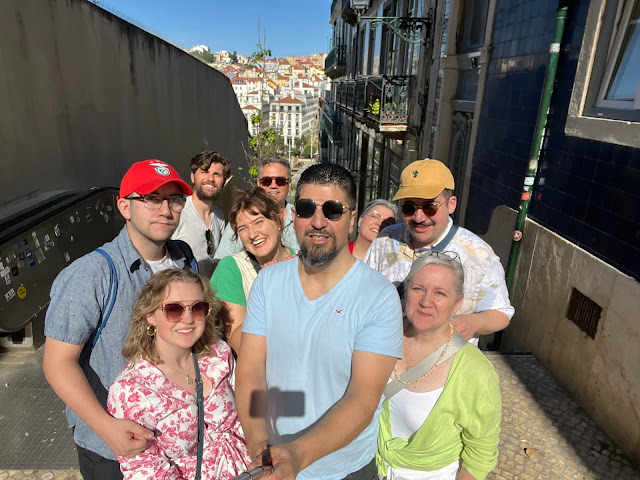1–9 March 2023
Porto
The name sums it up: with all the boats on the Douro, the daily encampment of vendors on its banks, and the seemingly endless stream of tourists, Porto looks and feels like a port. It has the cosmopolitan spirit that is part and parcel of commercial hubs, and its culture of exchange is reflected in both its architecture and its tourist industry. Many of the civic and financial buildings look less distinctly Portuguese than vaguely European, and the historic streets are always crowded with international visitors. Though this kind of diversity makes the city feel welcoming, it also leaves certain areas feeling slightly generic and gentrified. Still, the level of activity is exciting, and the scenery is beautiful.
I had a special experience on my second day, when, during a walking tour through the city centre, our guide drew attention to the many abandoned houses there. These are relics, he said, of the mass emigration that took place in the 1960s and 1970s, when over a million people fled the dictatorship in search of better lives. I told him it was interesting to see tangible signs of that history, which until then I had only read about. He replied that, since my grandparents emigrated at that time, I myself am a living sign of it. I then became a little emotional looking at those houses. I had never felt such a personal connection to history before, and the feeling was moving in a more general way because it drove home the fact that history is never just words on a page, but always someone’s experience.
Though I have enjoyed my time here, I am now looking forward to leaving the hustle and bustle of the city and embarking on a quieter and more reflective journey. Tomorrow I begin the Way of Saint James, which should be (God willing!) a rewarding adventure.
O Porto
O nome diz tudo: com todos os barcos no Douro, as tendas nas suas margens, e turistas incontáveis, a cidade do Porto parece um porto. Ele tem o espírito cosmopolita que é típico de centros comerciais, e a sua cultura de troca está refletida igualmente na sua arquitetura e na sua industria turística. Muitos dos edifícios municipais e financeiros parecem menos distintamente portugueses que vagamente europeus, e as ruas históricas estão sempre plenas de visitantes internacionais. Embora esta tipo da diversidade faz com que a cidade sinta-se acolhedora, ela também faz com que certas áreas pareçam genéricas e gentrificadas. No entanto, o nível da atividade é emocionante, e o cenário é lindo.
Eu tive um experiência especial na minha segunda dia, quando, durante um passeio a pé pelo centro da cidade, o nosso guia apontou aos muitas casas desertas ali. Estas são relíquias, ele disse, da emigração em massa que ocorreu nas décadas de 1960 e 1970, quando mais que um milhão de pessoas fugiram do Estado Novo em busca da vida melhor. Eu disse-lhe que é interessante ver sinais tangíveis dessa história, que até então eu só lera. Ele respondeu que, porque os meus avós saíram naquele tempo, eu seja um sinal vivo dessa. Então tornei-me um pouco emocionado a ver as casas. Nunca antes senti uma conexão tão pessoal a história, e o sentimento fez com que eu realize que história nunca é só palavras numa página, mas sempre uma experiência vivada dalguma pessoa.
Embora gostei do meu tempo aqui, estou agora ansioso para sair da cidade e começar uma viagem mais quieta e refletiva. Amanhã começarei o Caminho de Santiago, que deve ser (Deus quiser!) uma aventura gratificante.



























Comments
Post a Comment